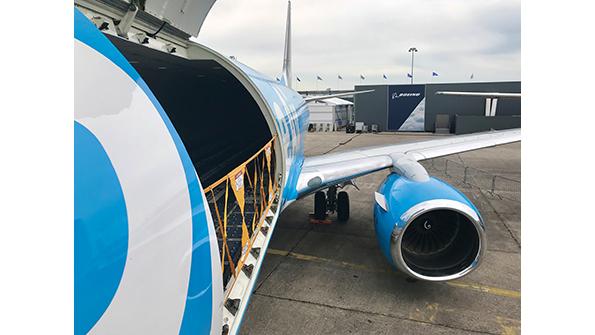
Boeing’s reshaping of its business amid internal struggles and the global passenger traffic downturn is touching nearly every aspect of the company’s air transport-focused operations, including parts of its services unit. One result appears to be added emphasis on leveraging proprietary elements and less focus on growth by aggregating aftermarket services.
“I expect services to continue to be a mid-single-to-double-digit growth portfolio,” President and CEO Dave Calhoun tells Aviation Week. “Our digital platform will be a double-digit grower and will take a lion’s share of our investment appetite with respect to services.”
The company’s Boeing Global Services (BGS) business generated $3.7 billion in revenue during the first quarter of 2021—55% of it from government customers and the rest from commercial entities. Two years ago, the total was 20% higher and the ratio reversed. The changes are largely due to the global commercial passenger business downturn that began in early 2020, a trend that hit most air transport businesses not focused on cargo revenue.
The commercial slump has led Boeing to reduce monthly production rates on its cornerstone 777 and 787 widebody programs. The 737 production rate is ramping back up after nearly two years of turmoil resulting from two fatal 737-8 accidents, in 2018 and 2019. The model was grounded around the world for 21 months—regulators in some countries, including China and India, still have not cleared it—and Boeing halted production for a brief period this year as part of recovery efforts.
BGS has not been spared in the company’s revamp. Once tapped by Boeing executives as a business that could hit $50 billion in annual revenue by the end of the decade, BGS is being retooled. While growth remains a goal, BGS will focus more on investing in products and services with high-capital-return potential, Calhoun says.
“We will earn our cost of capital in each of our discrete product lines,” he adds. “That is a different approach than where we were pre-COVID, when growth was the most important objective with less attention to returning our cost to capital. We will not turn wrenches just to turn wrenches.”
Boeing will continue to leverage demand for cargo lift through its expanding freighter conversion work and services that support all-cargo operations. The company recently announced a partnership with Coopesa to open a fourth conversion line for Boeing 737-800 converted freighters.
“We’re not going to give it all back when belly cargo returns, I don’t believe,” Calhoun says of dedicated freighter demand. “In fact, I don’t think we’re going to give that much back, because it’s not just the airplanes, it’s the reliance and configuration of the networks companies are using in accommodating these [aircraft]. I’m actually pretty bullish on [the cargo market] as a benefit coming out of here.”
Boeing also will continue to generate aftermarket revenue from its own intellectual property (IP), including parts for its aircraft programs. However, the company is less focused on capturing as much work as possible and will take the most prudent approach on a case-by-case basis.
“There are a lot of parts even our suppliers don’t want to provide the support for, and therein lies the opportunity for [Boeing Distribution Services] to really consolidate, use its economics, deliver on time, make things a little more predictable for the suppliers themselves, and frankly, [provide] better availability for our customers,” Calhoun says. “I think that’s intact, but the idea that we’re going to get some of the more technologically advanced packages [and] wrestle support away from technologically advanced suppliers, I’m a little less focused on that. That was definitely a focus before.”
While parts distribution will remain part of BGS’ activities, the days of it being a core focus may be coming to an end. Boeing has built a massive distribution business, primarily through its Aviall and KLX acquisitions. But Calhoun’s strategy may see further growth as not worth the investment.
“There are pieces of our portfolio that I am not likely to continue,” he said at the Bernstein Strategic Decisions conference in early June. “That really relates to delivering somebody else’s parts with no value added to a customer and suggesting that we add value, especially when it means I’ve got to invest a lot of capital underneath it. That’s not my idea of a big win,” he added.
“At a minimum, distribution does not seem to be a high priority for investment by Boeing,” Canaccord Genuity analyst Ken Herbert wrote in a research note following the Bernstein event. “But we also believe parts of the Boeing services portfolio may no longer be core for the company.”
While Boeing will not focus solely on pulling in ancillary services or maximizing BGS’ top-line growth, it is not about to pass up aftermarket-revenue generation opportunities on its products.
“With respect to new airplanes and control of the [intellectual property], control of the technology, there’s an opportunity for us as we move forward to ensure Boeing gets its rightful share of the services opportunities attached to our IP contribution,” Calhoun says. “I think it will be significant.”






Comments
This leads to less experience manufacturing, and hence less ability to do design, and eventually, they can no longer design the parts, and their suppliers become competitors who can actually make the product while Boeing cannot.
This happened to Dell computer in the 1990s, and it was not pretty.